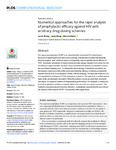2021-12-23Zeitschriftenartikel
Numerical approaches for the rapid analysis of prophylactic efficacy against HIV with arbitrary drug-dosing schemes
Zhang, Lanxin
Wang, Junyu
von Kleist, Max
Pre-exposure prophylaxis (PrEP) is an important pillar to prevent HIV transmission.
Because of experimental and clinical shortcomings, mathematical models that integrate
pharmacological, viral- and host factors are frequently used to quantify clinical efficacy of
PrEP. Stochastic simulations of these models provides sample statistics from which the clin-
ical efficacy is approximated. However, many stochastic simulations are needed to reduce
the associated sampling error. To remedy the shortcomings of stochastic simulation, we
developed a numerical method that allows predicting the efficacy of arbitrary prophylactic
regimen directly from a viral dynamics model, without sampling. We apply the method to var-
ious hypothetical dolutegravir (DTG) prophylaxis scenarios. The approach is verified against
state-of-the-art stochastic simulation. While the method is more accurate than stochastic
simulation, it is superior in terms of computational performance. For example, a continuous
6-month prophylactic profile is computed within a few seconds on a laptop computer. The
method’s computational performance, therefore, substantially expands the horizon of feasi-
ble analysis in the context of PrEP, and possibly other applications. Pre-exposure prophylaxis (PrEP) is an important tool to prevent HIV transmission. However, experimental identification of parameters that determine prophylactic efficacy is extremely difficult. Clues about these parameters could prove essential for the design of next-generation PrEP compounds. Integrative mathematical models can fill this void: Based on stochastic simulation, a sample statistic can be generated, from which the prophylactic efficacy is estimated. However, for this sample statistic to be accurate, many simulations need to be performed.
Here, we introduce a numerical method to directly compute the prophylactic efficacy from a viral dynamics model, without the need for sampling. Based on several examples with dolutegravir (DTG) -based short- and long-term PrEP, as well as post-exposure prophylaxis we demonstrate the correctness of the new method and its outstanding computational performance. Due to the method’s computational performance, a number of analyses, including formal sensitivity analysis, are becoming feasible with the proposed method.

